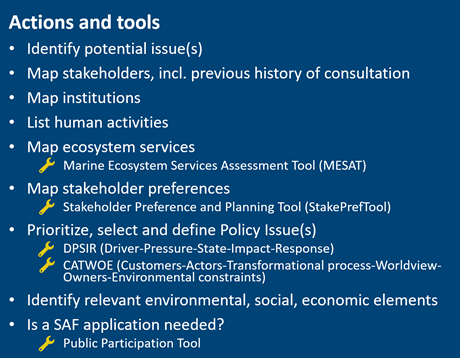The first step in the Systems Aproach Framework (SAF) is the Issue identification.
Actions and tools
The Issue identification step of the Systems Approach Framework (SAF) consists of a list of actions, which you can access in the menu to find more about each action.

Aim
The Issue identification step initiates the SAF process to achieve sustainable Integrated Coastal Management (ICM). It is about scoping the project, outlining the critical preliminary actions and setting the scene for undertaking community participation.
The Issue is usually a problem or a conflict that needs to be resolved. A solution needs to be found and implemented. However, if the system is not viewed as a whole, the decision may only have addressed the needs of one sector. Before you know it, a new conflict arises with new actors. The problem becomes a never-ending story, where the managers use resources defending unsustainable decisions and potentially non-compliant citizens oppose, resist or challenge the decision and its implementation.
With the SAF, decision making becomes a collaborative process. See Gillgren et al. 2018 for more information (find full reference in the Learn more box).
Duration
The Issue identification step can be completed within 2-3 months
Outcome
At the end of the Issue identification step you will have decided whether or not to initiate a SAF cycle and you have formed a core SAF team with the necessary expertise to conduct the work and have engaged the stakeholders that will be involved in the SAF application.
It should be kept in mind that the SAF application can be terminated during this step if the Issue is too simple or too complex to be applied with the available resources.
Learn more
Use the menu to learn more about the actions in the Issue identification process.
Find e-learning material about the Issue identification in the Learn more box on this page.
![]()